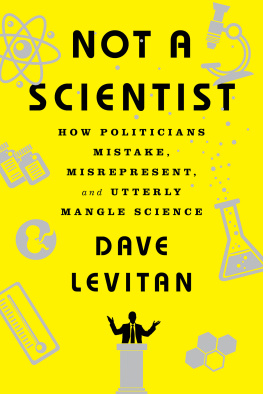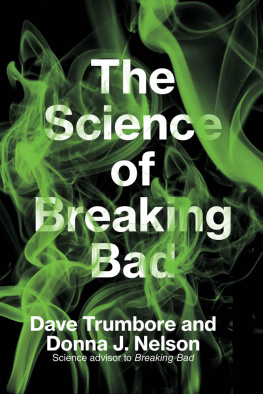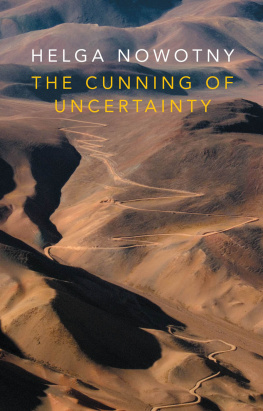

Copyright 2017 by Dave Levitan
All rights reserved
FIRST EDITION
For information about permission to reproduce selections
from this book, write to Permissions, W. W. Norton & Company, Inc.,
500 Fifth Avenue, New York, NY 10110
For information about special discounts for bulk purchases,
please contact W. W. Norton Special Sales at
specialsales@wwnorton.com or 800-233-4830
Book design by Barbara M. Bachman
Production managers: Anna Oler and Lauren Abbate
COVER DESIGN BY PETE GARCEAU
COVER ART: ISTOCKPHOTO.COM
THE LIBRARY OF CONGRESS HAS CATALOGED THE PRINTED EDITION AS FOLLOWS:
Names: Levitan, Dave.
Title: Not a scientist : how politicians mistake, misrepresent, and utterly
mangle science / Dave Levitan.
Description: First edition. | New York : W.W. Norton & Company, [2017] |
Includes bibliographical references and index.
Identifiers: LCCN 2016029048 | ISBN 9780393353327 (pbk.)
Subjects: LCSH: ScienceSocial aspects. | TechnologySocial aspects. |
SciencePolitical aspects. | TechnologyPolitical aspects.
Classification: LCC Q175.5 .L4745 2017 | DDC 303.48/3dc23 LC record
available at https://lccn.loc.gov/2016029048
ISBN 978-0-393-35333-4 (e-book)
W. W. Norton & Company, Inc.
500 Fifth Avenue, New York, N.Y. 10110
www.wwnorton.com
W. W. Norton & Company Ltd.
15 Carlisle Street, London W1D 3BS
To my wife, Jamie, and to Schrdingers cat.
The cat will know why, but only if you ask it.
T HROUGHOUT THE FOLLOWING PAGES, YOU WILL READ OF scientific errors and fabrications from a wide variety of politicians. You will see almost nothing, however, from President Donald Trump.
Do not let his absence from these pages fool you: what the new president does not know about science could fill a book on its own. The reasons for that absence relate not to Trumps actual statements on science, but in part to those statements utter inanity, and in part to timing.
To the latter point first: I completed this book before Trumps victory in November 2016, and even well before his nomination began to seem likely as the primary season progressed. Almost no one, pundit or politician alike, foresaw his ascendance, and during the writing process he seemed to me and to many others little more than a sideshow. By the time that assessment proved laughably false, the window to significantly change the content you find here had long since passed, and thus the leader of the free world is mostly absent from a book on politics and science.
The other reason to largely ignore him lies in the specific ways President Trump errs on science. As you will find throughout this book, there are a variety of subtle, nuanced, and sometimes downright malevolent ways to manipulate science toward political ends. Many elected officials are quite skilled at these methods of deception, and debunking their errors requires as much care and attention to detail as their crafted talking points did in the first place.
Donald Trump is not like those elected officials.
In short, his errors on scientific topics are so blatant, so crude, so lacking in even the most basic understanding of physics or biology or chemistry or any other discipline that debunking them often requires essentially no effort at all.
The concept of global warming was created by and for the Chinese in order to make U.S. manufacturing non-competitive, he tweeted in 2012. The preposterous nature of this claim, and many others like it, renders any sort of analysis unnecessary. Its just ridiculous; there is no evidence for it and in fact mountainsentire mountain rangesof evidence to the contrary. And while some of Trumps errors could find a home in the last chapter of the book (The Straight-Up Fabrication), most are more effectively laughed off than analyzed.
Of course, this is a terrifying state of affairs in which to find ourselves. A president who believes vaccines cause autism (they dont, as you will see in several chapters), who thinks torture works (it doesnt, along with being morally repugnant), who thinks wind turbines are the primary killers of birds (in reality, not even remotely close) just because he doesnt want the turbines near his golf coursethis doesnt bode well for many of the pressing science-related issues facing the country.
Further, while many of President Trumps errors are silly to an extreme extent, this does not mean that those surrounding him at the White House and in other leadership positions are so lacking in subtlety. With such anti-science attitudes now residing at the very top echelons of government, the tools presented here have arguably become more important. Holding our elected officials accountable for their misrepresentations of science could have remarkably far-reaching effects, with the impending doom related to climate change on top of the list.
As you read through these pages and learn to spot the various types of blunders and obfuscations, remember that President Trumps mistakes on science would be right at home in this collection, if only he was better at making them. Since he isnt, consider that he may have instead carved out his own brand of error: the firehose . Debunking an individual lie or error becomes much more difficulteven if it is an absurd error along the lines of the Earth is flatwhen there are dozens, hundreds, thousands of errors coming at you all at once.
This is where the danger Trump poses to scientific progress and more generally to the nation becomes clearer; hitting one tennis ball back across the net is easier than hitting 50. Which balls will pass us by? A regulation on oil and gas drilling that ignores the danger to water supplies? An executive order that sea level rise should not be considered in federal projects? Or just a series of late-night tweets denouncing state-level vaccination mandates?
Vigilance is the only antidote against a flood of misinformation, deception, and backwardness. If you spot any particularly egregious misuses of science from the President or any other politicians, call your senator or House representativelet them know that you want Washington to curtail its anti-science ways. With the longer view in mind, support efforts to improve science, technology, engineering, and math education, through nonprofits like Change the Equation. Collectively standing up to and fighting back against anti-science governance will keep the march of progress on its steady path.
NOT A
SCIENTIST
I N OCTOBER OF 1980, IN THE MIDST OF HIS FINAL CAMPAIGN push against incumbent President Jimmy Carter, Ronald Reagan addressed some environmental concerns during an event in Steubenville, Ohio. In his speech he presaged a trend in political rhetoric that would not truly rear its head for another three decades:
I have flown twice over Mount St. Helens out on our West Coast. Im not a scientist and I dont know the figures, but I just have a suspicion that that one little mountain out there has probably released more sulfur dioxide into the atmosphere of the world than has been released in the last 10 years of automobile driving or things of that kind that people are so concerned about.
Its true: the man who would soon become the fortieth president of the United States was not, in fact, a scientist. In spite of that lack of scientific training, he managed to express some opinions on science and science-related policy, in this case about how much sulfur dioxidethe primary culprit in the formation of acid rainthat one little mountain emits compared to human sources. Of course, Reagan also wasnt an economist, or an immigration lawyer, or an expert on the Middle East, but he had plenty to say and do about those issues as well. In general, the president doesnt need to remind us of the things he is not qualified to do; we tacitly trust that in spite of those shortcomings, he might have a few experts on hand to answer some questions.
Next page







![Brian Godsey [Brian Godsey] - Think Like a Data Scientist: Tackle the data science process step-by-step](/uploads/posts/book/119618/thumbs/brian-godsey-brian-godsey-think-like-a-data.jpg)


